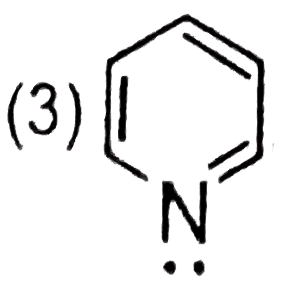Which of the following compounds is most susceptible to a nucleophilic attack at the carbonyl group?
(a)CH3COOCH3
(b)CH3CONH2
(c)CH3COOCOCH3
(d) CH3COCl
CH3COOCH3
CH3CONH2
CH3COOCOCH3
CH3COCl
The correct Answer is:D
To determine which of the given compounds is most susceptible to a nucleophilic attack at the carbonyl group, we need to analyze the electrophilicity of the carbonyl carbon in each compound and the quality of the leaving groups attached.
1. Identify the Compounds:
- (a) CH3COOCH3 (Methyl acetate)
- (b) CH3CONH2 (Acetamide)
- (c) CH3COOCOCH3 (Diethyl carbonate)
- (d) CH3COCl (Acetyl chloride)
2. Analyze the Electrophilicity:
- The electrophilicity of the carbonyl carbon is influenced by the presence of electron-donating or electron-withdrawing groups.
- Electron-donating groups (like -OCH3 and -NH2) will decrease the electrophilicity of the carbonyl carbon, making it less susceptible to nucleophilic attack.
- Electron-withdrawing groups (like -Cl) will increase the electrophilicity of the carbonyl carbon, making it more susceptible to nucleophilic attack.
3. Evaluate Each Compound:
- (a) Methyl acetate (CH3COOCH3): The -OCH3 group donates electron density through resonance, decreasing the electrophilicity of the carbonyl carbon.
- (b) Acetamide (CH3CONH2): The -NH2 group also donates electron density through resonance, similarly decreasing the electrophilicity of the carbonyl carbon.
- (c) Diethyl carbonate (CH3COOCOCH3): The presence of two -O groups can lead to some resonance stabilization, which may decrease the electrophilicity of the carbonyl carbon.
- (d) Acetyl chloride (CH3COCl): The -Cl group is a strong electron-withdrawing group and does not donate electron density. It is also a very good leaving group, which enhances the electrophilicity of the carbonyl carbon.
4. Conclusion:
- Among the four compounds, acetyl chloride (CH3COCl) has the most electrophilic carbonyl carbon due to the presence of the -Cl group, which is a strong electron-withdrawing group and a good leaving group. Therefore, it is the most susceptible to nucleophilic attack.
Final Answer:
The compound most susceptible to a nucleophilic attack at the carbonyl group is (d) CH3COCl.
- (a) CH3COOCH3 (Methyl acetate)
- (b) CH3CONH2 (Acetamide)
- (c) CH3COOCOCH3 (Diethyl carbonate)
- (d) CH3COCl (Acetyl chloride)
- The electrophilicity of the carbonyl carbon is influenced by the presence of electron-donating or electron-withdrawing groups.
- Electron-donating groups (like -OCH3 and -NH2) will decrease the electrophilicity of the carbonyl carbon, making it less susceptible to nucleophilic attack.
- Electron-withdrawing groups (like -Cl) will increase the electrophilicity of the carbonyl carbon, making it more susceptible to nucleophilic attack.
- (a) Methyl acetate (CH3COOCH3): The -OCH3 group donates electron density through resonance, decreasing the electrophilicity of the carbonyl carbon.
- (b) Acetamide (CH3CONH2): The -NH2 group also donates electron density through resonance, similarly decreasing the electrophilicity of the carbonyl carbon.
- (c) Diethyl carbonate (CH3COOCOCH3): The presence of two -O groups can lead to some resonance stabilization, which may decrease the electrophilicity of the carbonyl carbon.
- (d) Acetyl chloride (CH3COCl): The -Cl group is a strong electron-withdrawing group and does not donate electron density. It is also a very good leaving group, which enhances the electrophilicity of the carbonyl carbon.
- Among the four compounds, acetyl chloride (CH3COCl) has the most electrophilic carbonyl carbon due to the presence of the -Cl group, which is a strong electron-withdrawing group and a good leaving group. Therefore, it is the most susceptible to nucleophilic attack.
The compound most susceptible to a nucleophilic attack at the carbonyl group is (d) CH3COCl.
Similar Questions
Which of the following compounds will not exist as resonance hybrid. Give reason for your answer.
(a) CH3OH
(b) R−CONH2
(c) CH3CH=CHCH2NH2
View SolutionCH3CONH2&HCONHCH3 are called
View SolutionWhich of the following pairs is expected to exhibit H-bonding
(a) CH3CH2OH and CH3OCH3
(b) CH3NH2 and CH3SH
(c ) CH3OH and (CH3)3N .
View SolutionOutline the preparation of the following compounds using a nucleophilic substitution reaction : CH3C≡CCH2CH3
View SolutionWhich of the following compounds will not give positive iodoform test.
Acetophenone, Benzophenone, 2-Pentanone, 3-Pentanone, Acetaldehyde,
CH3COCH3,(CH3)2CHOH,(CH3CH2)2CH−OH,CH3COOH,CH3CONH2,CH3COOCH3,CH3COCl
View Solution
When a nucleophile attack to carbonyl group of a carboxylic acid derivative, the carbon-oxygen π- bond breaks. The resulting intermediate is called a tetrahedral intermediate because sp2 carbon in the reactant has become a tetrahedral (sp3) carbon in the intermediate.
Here ..Yɵ is leaving group, the weaker base is expelled preferentially.
Q. Which of the following given compounds don't form amide, when react with CH3COCl.
(1). CH3−NH−CH3
(2). CH3−N∣CH3−CH2H5
(3).
(4). CH3−CH2−CH2−NH2
View SolutionWhich of the following carbocation is most stable ?
(a) (CH3)3C.+CH2 (b) (CH3)3+C (c) CH3CH2+CH2 (d) CH3+CHCH2CH3
View SolutionThe increasing order of nucleophilicity of the following nucleophiles is:
(a) CH3CO−2 (b) H2O (c) CH3SO−3 (d) OH
View SolutionArrange the following compounds in increasing order of their boiling points.
CH3CHO,CH3CH2OH,CH3OCH3,CH3CH2CH3
View SolutionArrange the following compounds in the increasing order of their boiling points:
CH3CH2CH2CHO,CH3CH2CH2CH2OH,H5C2−O−C2H5,CH3CH2CH2CH3
View Solution
